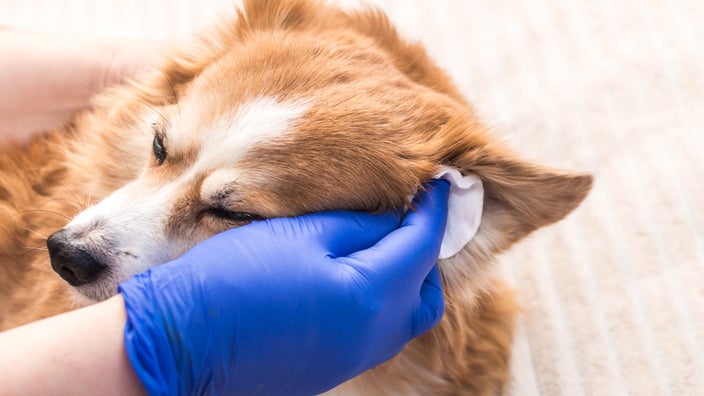
How to Clean Your Dog’s Ears: An At-Home Guide for Pet Owners
Key takeaways:
Check your dog’s ears regularly to see when they need cleaning. Dogs can have buildup of debris and earwax.
Use a veterinary-approved ear cleaning solution, and follow the steps in this article to safely clean your dog’s ears at home.
If you suspect that your dog may have an ear infection, take them to the veterinarian for diagnosis and treatment.
Table of contents

Cleaning your dog’s ears regularly can help remove any dirt, wax buildup, and moisture that’s left after a bath or swimming. Plus, maintaining healthy ears can prevent ear infections, which are often painful and could lead to complications or even permanent damage to the ear if left untreated.
So how do you safely clean your dog’s ears? Here is a step-by-step guide to get you started.
How to clean your dog’s ears
To safely clean your dog’s ears, follow these steps.
Search and compare options
1. Position your dog
To get ready to clean your dog’s ears, hold your dog on the floor, or place them on a table. Sit or stand on the side of the dog opposite to the ear you are cleaning. Then, put one arm over your dog’s shoulders and the other around their head and neck.
2. Apply cleaner to the ear
Expose the inner ear by gently lifting the ear flap back. Squeeze the veterinarian-approved cleanser into your dog’s ear canal. Alternatively, you can soak a cotton ball in the cleanser and place it in the ear. Do not insert the cotton ball directly into the ear canal.
3. Thoroughly clean your dog’s ears
Massage the base of your dog’s ear to allow the cleanser to enter the ear canal. Wipe the visible part of the ear clean using a cotton ball.
Work from the inside of your dog’s ear outward to their ear flap. When you’re cleaning inside your dog’s ear, only go as far in as your finger can easily fit. Otherwise, you might cause the dirt to get stuck in your dog’s ear canal.
4. Remove extra liquid
Allow your dog to shake off any of the excess liquid. Afterward, clean the ear with a dry cotton ball, and repeat the process if needed.
5. Reward your pup
Make ear cleaning a positive experience for your dog by going slowly and gently and offering plenty of rewards.
Does your dog have an ear infection? Here are the most common signs your dog may need to see a veterinarian for treatment.
Ear mites in dogs: Ear mites are tiny pests that can cause a big problem for your dog. Here’s how to tell if your pup may have ear mites and what to do about it.
Signs of hearing loss: Like humans, aging dogs can develop hearing loss. Check out some easy tests you can try at home to see if your dog is losing their hearing.
What can you use to safely clean your dog’s ears?
To safely clean a dog’s ears, you will need cotton balls or cotton gauze pads. Do not use cotton swabs — they can push the debris further inside your pup’s ears. You will also need a cleaning solution made for dogs.
Jamie Richardson, head of veterinary medicine at Small Door Veterinary, recommends only using a veterinary-approved ear cleaner. They are readily available at physical and online pet stores, as well as at your veterinarian’s office.
Do not use alcohol or hydrogen peroxide (or products that contain them) to clean your dog’s ears. Also stay away from popular online home remedies such as vinegar or olive oil. These products can cause harm to your dog.
Read more like this
Explore these related articles, suggested for readers like you.
Can you clean a dog’s ears without solution?
It’s not recommended to clean your dog’s ears without a dog-specific cleaning solution. Cleaning solutions made specifically for pets are the most effective way to keep your dog’s ears clean.
How often should you clean your dog’s ears?
How often your dog needs their ears cleaned will depend on how often they get ear debris buildup or ear infections, said Richardson. Frequently examine your dog’s ears to know when it’s time to clean. A clean ear will be pink in color and won’t smell.
According to Richardson, most dogs don’t need their ears cleaned monthly, only periodically. However, some dogs may need ear cleanings more frequently.
Factors that may lead to the need for more frequent ear cleanings include:
Skin allergies
Breeds with long, dangling ears, such as basset hounds and cocker spaniels
Excess hair in and around the ear canal
Frequent ear infections
Spending a lot of time in the water
Common mistakes when cleaning dog ears
To make sure your dog’s ear cleaning is safe and comfortable for them:
Never use Q-tips to clean your pet’s ears. “They risk perforating the eardrum, and they can also push dirt further into the ear and lead to infection,” said Richardson.
Avoid using products such as hydrogen peroxide, rubbing alcohol, or vinegar. These can irritate the inside of your dog’s ear and lead to more damage.
Use a liquid ear-cleaning solution instead of wipes. This is because dogs have long and narrow ear canals. Wipes may not reach down into the ear canal to clean it properly.
Be careful not to over-clean your dog’s ears. Cleaning them too often can cause irritation and lead to infection. Consult with your veterinarian about how often your dog needs their ears cleaned based on their breed and lifestyle.
When to take your dog to the vet for an ear checkup
Take your dog to the veterinarian if you suspect that they have an ear infection. “Cleaning an infected ear can be very painful and may cause more damage if not done correctly,” said Richardson.
Keep a lookout for the following signs of an ear infection:
Swelling or redness
Itching or pain
Shaking or tilting the head
Pawing or scratching at their ear
Discharge coming from the ear
A bad or weird smell (yeast infections in particular have a distinctive smell)
Ear infections will not go away on their own and can cause permanent damage leading to hearing loss if left untreated.
Frequently asked questions
Look for an ear cleaning solution that’s designed to help clean wax out of a dog’s ears. These products will be made specifically for dogs and state on the label that they help with wax buildup.
You cannot treat a dog’s ear infection without a veterinarian. Ear infections won’t go away on their own, and your dog will need a treatment plan to effectively get rid of the infection.
The bottom line
Cleaning your dog’s ears is an essential part of being a pet parent. Check your canine’s ears regularly to see if they need cleaning. Excessive buildup of debris or earwax could lead to infections if left uncleaned. If your dog has allergies, long ears, or excessive fur, they may need more regular ear cleanings.
Ear cleaning is a simple task that you can do safely at home with an ear-cleaning solution. Talk to your veterinarian if you suspect that your dog may have an ear infection.
Why trust our experts?



References
Brooks, W. (2020). Ear infections (otitis) in dogs. VeterinaryPartner.
Washington State University College of Veterinary Medicine Veterinary Teaching Hospital. (2022). Examining and medicating the ears of a dog.
Cohen, A. (2024). How to clean your dog’s ears. Cornell Richard P. Riney Canine Health Center.
VIN Dermatology Consultants. (2023). Otitis externa treatment in dogs and cats. Veterinary Partner.





























